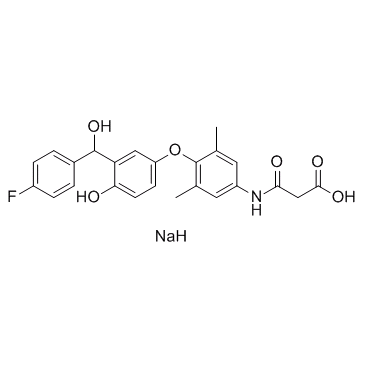| Description |
KAT681 is a liver-selective thyromimetic.
|
| Related Catalog |
|
| Target |
Thyroid Hormone Receptor[1]
|
| In Vitro |
The impact of the liver-selective thyromimetic KAT681 (T-0681) is investigated on lipoprotein metabolism. Prolonged treatment with KAT681 increases the hepatic expression of both low-density lipoprotein (LDL) receptor and scavenger receptor class B, type I without affecting cholesteryl ester transfer protein activity. Western blot showing human SR-BI (CLA-1) expression in normal HepG2 cells and in HepG2 cells loaded with AcLDL and subsequently incubated with vehicle or KAT681. SR-BI protein expression is markedly downregulated by incubation with 50 μg/mL AcLDL. This effect can not be reversed by addition of KAT681[1]
|
| In Vivo |
In preliminary dose-titration studies, a marked decrease of plasma cholesterol is observed at 36 nmoles/kg/day KAT681 (T-0681), whereas doses higher than 36 nmoles/kg/day show no further lipid-lowering effect. In the subsequent study, New Zealand White (NZW) rabbits are fed a 0.2% cholesterol diet and dosed with 36 nmoles/kg/day KAT681 or a respective placebo control for 4 weeks. KAT681 treatment results in a 60% decrease of plasma cholesterol and a 70% decrease of plasma triglycerides[1]. In preliminary dose-titration studies in wild-type (WT) mice, a marked increase of hepatic SR-BI expression at 36 nmol/kg/d KAT681 (T-0681), and a concomitant 50% decrease of plasma cholesterol are observed. Higher doses than 36 nmol/kg/d show no further lipid-lowering effect. KAT681 significantly increases hepatic LDLrs in SR-BI KO mice (2-fold of controls, P<0.01), along with a marked decrease in plasma cholesterol[2].
|
| Cell Assay |
HepG2 cells are used. At a confluency of 70%, HepG2 cells are incubated with 50 μg/mL of acetylated LDL (AcLDL) for 24 h and subsequently treated with indicated amounts of KAT681 (0.5 μM) in serum-free medium for another 24 h. Cellular protein extraction and Western blot analysis are performed.
|
| Animal Admin |
Rabbits[1] Male NZW rabbits are subcutaneously implanted with Alzet osmotic pumps carrying KAT681 (36 nmoles/kg/day) in 1% DMSO/PBS or 1% DMSO/PBS alone as control for the entire duration of the studies. Rabbits are fed a 0.2% cholesterol and 3.5% fat diet or a 2% cholesterol and 5% fat diet. Food consumption is restricted to 100 g/day/animal. At the end of the studies, animals are fasted 5 h before the collection of blood samples, killed by a threefold overdose of pentobarbital, and organ biopsies snap-frozen. Mice[2] Male C57/B6 (WT) mice are fed a standard chow diet. After 2 weeks of acclimatization, mice are divided into two groups and subcutaneously implanted with Alzet micro-osmotic pumps carrying KAT681 in PBS (36 nmol/kg/d) or PBS alone as control for 14 days. After 14 days of treatment, animals are fasted for 5 h and anesthetized. Blood samples are taken, mice sacrificed by cervical dislocation, and organ biopsies are snap-frozen. Male SR-BI KO and LDLr KO mice are fed a standard chow diet, and subcutaneously implanted with Alzet micro-osmotic pumps carrying KAT681 in PBS (36 nmol/kg/d) or PBS alone as control. Mice are then fasted for 5 h, blood samples are taken, mice are sacrificed by cervical dislocation, and liver biopsies are snap-frozen.
|
| References |
[1]. Tancevski I, et al. The thyromimetic T-0681 protects from atherosclerosis. J Lipid Res. 2009 May;50(5):938-44. [2]. Tancevski I, et al. The liver-selective thyromimetic T-0681 influences reverse cholesterol transport and atherosclerosis development in mice. PLoS One. 2010 Jan 15;5(1):e8722.
|
